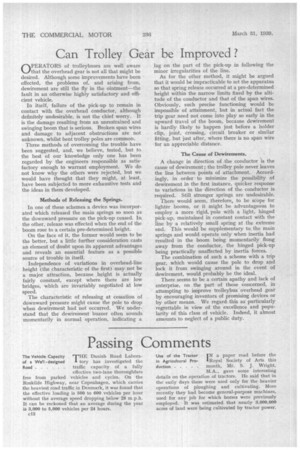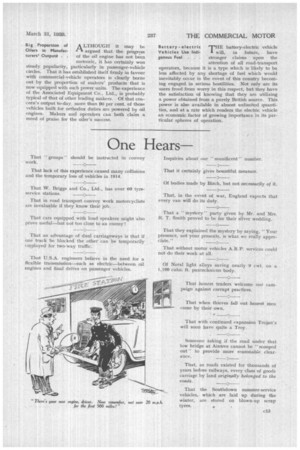Passing Comments
Page 66

Page 67

If you've noticed an error in this article please click here to report it so we can fix it.
The Vehicle Capacity THE Danish Road Labora
of a Weil -designed tory has investigated the
Road traffic capacity of a fully
effective two-lane thoroughfare free from parked vehicles and cycles. On the Roskilde Highway, near Copenhagen, which carries the heaviest road traffic in Denmark, it was found that the effective loading is 500 to 600 vehicles per hour without the average speed dropping below 28 m.p.h. It can be reckoned that an average during the year is 3,000 to 5,000 vehicles per 24 hours.
c12 Use of the Tractor IN a paper read before the
in Agricultural Pro!Royal Society of Arts this
duction month, Mr. S. J. Wright, M.A., gave some interesting details on the operation of tractors. He said that in the early days these were used only for the heavier operations of ploughing and cultivating. More recently they had become general-purpose machines, used for any job for which horses were previously employed. It was estimated that nearly 3,000,000 acres of land were being cultivated by tractor power.
AL LTHOUGH it may be rl argued that the progress of the oil engine has not been meteoric, it has certainly won steady popularity, particularly in passenger-vehicle circles. That it has established itself firmly in favour with commercial-vehicle operators is clearly borne out by the proportion of makers' products that is now equipped with such power units. The experience of the Associated Equipment Co., Ltd., is probably typical of that of other leading makers. Of that concern's output to-day, more than 90 per cent. of those vehicles built for orthodox duties are powered by oil engines. Makers and operators can both claim a meed of praise for the oiler's success.
Big Proportion of Oilers in Manufacturers' Outputs .
Battery-electric THE battery-electric vehicle
Vehicles Use IndiI Null, in future, have genous Fuel . . . stronger claims upon the attention of all road-transport operators, because it is a type which is likely to be less affected by any shortage of fuel which would inevitably occur in the event of this country becoming engaged in serious hostilities. Not only are its users freed from worry in this respect, but they have the satisfaction of knowing that they are utilizing a power obtained from a purely British source. This power is also available in almost unlimited quantities, and at a rate which renders the electric vehicle an economic factor of growing importance in its particular spheres of operation.
























































































































































